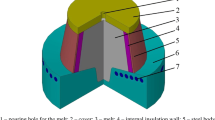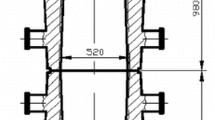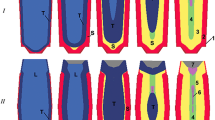Abstract
The work’s purpose is to increase the forging ingot’s quality. A crystallization mechanism of shortened ingots has been investigated. The shortened ingots allow changing a direction of the metal solidification. The rational geometry of the ingot (a ratio of height to diameter and a value of taper) needs to be determined. The special technique of the theoretical and experimental investigations has been developed. The theoretical investigations have been carried out by finite element method. An adequacy test of the theoretical results has been carried out by experimental investigations on transparent and metallic models (pure aluminum) of the ingots. The macrostructure investigations of the shortened ingots with directional solidification have been produced. A hardness distribution on the longitudinal section has been investigated. It was found that for the ingot with the ratio of H/D = 1.1 the most part of the ingot’s body (60–70%) has a dense, homogeneous and small-grained structure. The small grain, which provides a dense structure, forms at the bottom and in the corners from the bottom side. The distribution of the grain dimensions along the ingot radius at different height levels allows to conclude that the bottom and middle parts along the height have the same small-grained structure. The high and uniform hardness values are characteristic for the ingot with H/D = 1.1. The middle and hot-top layers of the ingot have commensurate hardness, which have a difference from the bottom part maximum on the 5%. The ingot with the reverse taper of 7% allows to make a most dense and homogeneous structure. Thus, the improvement in the large forged quality ingots is possible by providing the directional solidification and reverse taper.













Similar content being viewed by others
References
Stahlberg U, Keife H, Lundberg M, Melander A (1980) A study of void closure during plastic deformation. J Mech Work Technol 4(1):51–63. https://doi.org/10.1016/0378-3804(80)90005-4
Wołczyński W, Kwapisiński P, Kania B, Wajda W, Skuza W, Bydałek AW (2015) Numerical model for solidification zones selection in the large ingots. Arch Foundry Eng 15(4):87–90
Shi Ping W, Liu DR, Guo JJ, Yan Qing S, Heng Zhi F (2007) Influence of process parameters on CET in Ti–Al alloy ingot with consideration of shrinkage cavity formation: a computer simulation. J Alloys Compd 441:267–277. https://doi.org/10.1016/j.jallcom.2006.09.094
Tu W, Zhang X, Shen H, Liu B (2014) Numerical simulation on multiple pouring process for a 292 t steel ingot. Res Dev 11(1):52–58
Girardin G, Jobard D, Perdriset F, Tollini P, Poitrault I, Gingell A (2011) Hollow ingots: thirty years of use to control segregation and quality for nuclear and petrochemical large shells. In: 18th international forgemasters meeting, 12–15 September, Pittsburgh, pp 170–174
Durynin VA, Solntsev YP (2006) Issledovanie I sovershenstvovanie tekhnologii proizvodstva s tselyu povysheniya resursa stalnykh izdeliy is krupnykh pokovok otvetstvennogo naznachenia (Study and improvement of production technology for increase of service life of steel products of responsible usage). Saint-Petersburg: Khimizdat. 272 p (In Russia)
Smirnov AN (2008) Zatverdevanie metallicheskogo rasplava pri vneshnikh vozdeistviyakh (Solidification of metal melt in the conditions of external effects). Donetsk: VIK Publishers 250 p (In Ukrainian)
Efimov VA, Eldarkhanov AS (2004) Tekhnologii sovremennoy metallurgii (Modern metallurgical technologies). Moscow: Novye tekhnologii 784 p (In Russia)
Lesoult G (2005) Macrosegregation in steel strands and ingots: characterisation, formation and consequence. Mater Sci Eng A Struct Mater Prop Microstruct Process 413(414):19–29. https://doi.org/10.1016/j.msea.2005.08.203
Pickering EJ, Chesman C, Al-Bermani S, Holland M, Davies P, Talamantes-Silva J (2015) A comprehensive case study of macrosegregation in a steel ingot. Metall Mater Trans B 46(4):1860–1874. https://doi.org/10.1007/s11663-015-0386-y
Wang J, Paixian F, Liu H, Li D, Li Y (2012) Shrinkage porosity criteria and optimized design of a 100-ton 30Cr2Ni4MoV forging ingot. Mater Des 35:446–456. https://doi.org/10.1016/j.matdes.2011.09.056
Ludwig A, Wu M, Kharicha A (2015) On macrosegregation. Metall Mater Trans A 46(11):4854–4867. https://doi.org/10.1007/s11661-015-2959-4
Wu M, Ludwig A, Kharicha A (2017) A four phase model for the macrosegregation and shrinkage cavity during solidification of steel ingot. Appl Math Model 41:102–120. https://doi.org/10.1016/j.apm.2016.08.023
Berndt CC, Brindley W, Goland AN, Herman H, Houck DL, Jones K, Miller RA, Nieser R, Riggs W, Sampath S, Smith M, Spanne S (1992) J Therm Spray Technol 1(4):341
Xu B, Sun M, Li D (2014) The void close behavior of large ingots during hot forging. In: 19th international forgemasters meeting, 29 September–3 October 2014, Makuhari, pp 141–145
Kukhar V, Artiukh V, Serduik O, Balalayeva E (2016) Form of gradient curve of temperature distribution of lengthwise the billet at differentiated heating before profiling by buckling. Procedia Eng 165:1693–1704. https://doi.org/10.1016/j.proeng.2016.11.911
Flemings MC (1974) Solidification processing. Metall Trans 5(10):2121–2134. https://doi.org/10.1007/BF02643923
Sobolev VV (1991) Gas porosity formation kinetics in granule crystallization. Powder Metall Met Ceram 30(4):263–267. https://doi.org/10.1007/BF00795952
Sobolev VV, Guilemany JM (1996) The formation of coating shrinkage porosity in the process of thermal spraying. J Mater Process Technol 58(2–3):227–232. https://doi.org/10.1016/0924-0136(95)02100-0
Kukhar V, Burko V, Prysiazhnyi A, Balalayeva E, Nahnibeda M (2016) Development of alternative technology of dual forming of profiled workpiece obtained by buckling. East Eur J Enterp Technol 3/7(81):53–61. https://doi.org/10.15587/1729-4061.2016.72063
Keizo O (2003) Improving the technology of high-large forgings. Iron Steel Instr 7:484–490
Balcar M, Zelezny R, Sochor L, Fila P, Martinek L (2008) The development of a chill mould for tool steels using numerical modeling. J Mater Technol 42(4):183–188
Zhbankov IG, Markov OE, Perig AV (2014) Rational parameters of profiled workpieces for an upsetting process. Int J Adv Manuf Technol 72:865–872. https://doi.org/10.1007/s00170-014-5727-5
Ao GW, Shen MG, Zang ZS, Li BL (2016) Study on unidirectional solidification ingot with hollow lateral wall insulation. Metalurgija 55(4):597–600
Markov OE (2012) Forging of large pieces by tapered faces. Steel Transl 42(12):808–810. https://doi.org/10.3103/S0967091212120054
Xu CJ, Zeng YX, Wang ZL, Li J, Li SL, Zhang XJ (2016) Magnetic field distribution in the electromagnetic feeding riser of rectangle steel ingot. Metalurgija 55(4):593–596
Markov OE, Perig AV, Markova MA, Zlygoriev VN (2016) Development of a new process for forging plates using intensive plastic deformation. Int J Adv Manuf Technol 83(9–12):2159–2174. https://doi.org/10.1007/s00170-015-8217-5
Heidarzadeh M, Keshmiri H (2013) Influence of mould and insulation design on soundness of tool steel ingot by numerical simulation. J Iron Steel Res Int 20(7):78–83. https://doi.org/10.1016/S1006-706X(13)60130-2
Markov O, Gerasimenko O, Aliieva L, Shapoval A (2019) Development of the metal rheology model of high-temperature deformation for modeling by finite element method. EUREKA Phys Eng 2:52–60. https://doi.org/10.21303/2461-4262.2019.00877
Markov OE, Perig AV, Zlygoriev VN, Markova MA, Grin AG (2017) A new process for forging shafts with convex dies. Research into the stressed state. Int J Adv Manuf Technol 90:801–818. https://doi.org/10.1007/s00170-016-9378-6
Markov OE, Perig AV, Zlygoriev VN, Markova MA, Kosilov MS (2017) Development of forging processes using intermediate workpiece profiling before drawing: research into strained state. J Braz Soc Mech Sci Eng 39(4):4649–4665. https://doi.org/10.1007/S40430-017-0812-Y
Markov OE, Oleshko MV, Mishina VI (2011) Development of energy-saving technological process of shafts forging weighting more than 100 tons without ingot upsetting. Metall Min Ind 3(7):87–90
Sikulskiy V, Kashcheyeva V, Romanenkov Yu, Shapoval A (2017) Study of the process of shape-formation of ribbed double-curvature panels by local deforming. Eas Eur J Enterp Technol 4(88):43–49. https://doi.org/10.15587/1729-4061.2017.108190
Carlson KD, Beckermann C (2009) Prediction of shrinkage pore volume fraction using a dimensionless Niyama criterion. Metall Mater Trans 40A(1):163–175. https://doi.org/10.1007/s11661-008-9715-y
Jain N, Carlson KD, Beckermann C (2007) Round robin study to assess variations in casting simulation Niyama criterion prediction. In: Proceedings. 61st technical and operating conference. Steel Founders’ Society of America, Chicago, p 29
Sztwiertnia K, Pospiech J, Rostek T, Faryna M (2002) Microstructure development in ridging affected stainless steel. Arch Metall 47:197–204
Markov O, Zlygoriev V, Gerasimenko O, Hrudkina N, Shevtsov S (2018) Improving the quality of forgings based on upsetting the workpieces with concave facets. East Eur J Enterp Technol 5(1–95):16–24. https://doi.org/10.15587/1729-4061.2018.142674
Funding
Funding was provided by Ministry of Education and Science of Ukraine (Grant No. 0118U003047).
Author information
Authors and Affiliations
Contributions
All authors participated in the design of this work and performed equally. All authors read and approved the final manuscript.
Corresponding author
Ethics declarations
Conflict of interest
The authors Oleg E. Markov, Oleksiy V. Gerasimenko, Volodymyr V. Kukhar, Oleksandr R. Abdulov and Nadiia V. Ragulina declare that there is no conflict of interests regarding the publication of this paper.
Additional information
Technical Editor: Lincoln Cardoso Brandao.
Publisher's Note
Springer Nature remains neutral with regard to jurisdictional claims in published maps and institutional affiliations.
Rights and permissions
About this article
Cite this article
Markov, O.E., Gerasimenko, O.V., Kukhar, V.V. et al. Computational and experimental modeling of new forging ingots with a directional solidification: the relative heights of 1.1. J Braz. Soc. Mech. Sci. Eng. 41, 310 (2019). https://doi.org/10.1007/s40430-019-1810-z
Received:
Accepted:
Published:
DOI: https://doi.org/10.1007/s40430-019-1810-z




